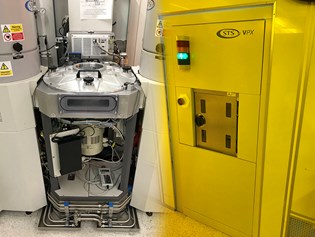01 Jun 2018

Semefab has made a $750k investment in advanced MEMS sensor technology with a second dual chamber STS VPX DRIE etcher which complements its existing STS Pegasus DRIE capability. This second tool will cater for higher volume and additional specialised etching processes. The new tool is configured as follows: Chamber 1: Si, SiO2, Si3N4, Chamber 2: Si, SiO2. Both chambers are fitted with Electrostatic chucks with the second APS chamber also suitable for etching Platinum and PZT.
The new tool is being installed in Semefab's Fab 2 MEMS facility and will add significant additional capabilities to our already extensive MEMS process platforms. In particular, the ability to etch cavities and relieve surface membranes for pressure, gas, thermopile and micro-hotplate structures will be possible on wafers which have heavy metals such as Gold and Platinum already deposited.
Semefab's first DRIE etcher, the STS Pegasus tool and has been maintained as a metal ion free 'clean' DRIE machine associated solely with Semefab's Fabs 1 and 3 which are both MOS/Bipolar facilities. MEMS devices at Semefab benefit from starting their processing in Fabs 1 or 3 where long carrier lifetimes and low junction leakages are guaranteed by the complete absence of alkali metal (Na, K, Li) mobile ionic contamination and heavy metals (Au and Pt), allowing high performance, low leakage electrically active structures to be ion implanted and diffused. Those wafers requiring heavy metal processing are transferred to Fab 2 for the subsequent low temperature processing including sputtering and definition of Gold, Platinum or other metals. Here, these processes can be safely carried out to completion of the MEMS process without risk to the integrity of either of the MOS/Bipolar fabs, essential for producing reproducible, ultra low leakage junction performance in MEMS. Semefab’s Fab 2 is completely isolated from Fabs 1 and 3 and has separate services and facilities. A strict ‘one way traffic’ rule is observed for product passing from Fabs 1 and 3 to Fab 2, ensuring no risk of cross contamination.
The addition of the second DRIE tool to Fab 2 not only adds the ability to etch a variety of new materials and layers in addition to silicon but also removes a restriction requiring KOH etching for certain processes which leads to large die size due to the etch slope. Now we can offer Semefab's customers the cost benefit of smaller die size resulting from DRIE near vertical anisotropic etching across all MEMS processes.
Read Next
-
26 Oct 2022
Semefab ceasing manufacture on 4 inch wafers.
-
18 Aug 2022
Semefab's Annual Awards Recognise STEM Students
-
17 Aug 2022
Allan James addresses NMI Techworks
-
25 Feb 2022
Semefab wins Fife Civic Recognition Award
-
16 Feb 2022
Semefab sets sight on growth
-
17 Jan 2022
Semefab shortlisted for Fife Business Awards 2022
-
27 Aug 2021
Taicaan Research & Semefab in strategic RF MEMS alliance
-
24 Jun 2021
Semefab Dr John Bruce Memorial Awards 2021
-
06 Apr 2021
Best yet to come at Semefab
-
23 Dec 2020
Semefab has strong 2020 and 2021 outlook is better
-
26 Oct 2020
Dr John Bruce Memorial/Semefab STEM Awards 2020
-
17 Jul 2020
Semefab enters Power Semis market
-
22 Apr 2020
Semefab & UWS produce anti-virus technology
-
06 Apr 2020
SNP Westminster Commend Semefab
-
19 Mar 2020
Semefab on war footing against coronavirus
-
06 Mar 2020
Semefab chips in demand to help fight Coronavirus
-
02 Oct 2019
Semefab launches STEM Glenrothes schools partnership
-
29 Mar 2019
Fife Business Awards 2019
-
20 Nov 2018
Semefab and Ilika announce Partnership
-
12 Oct 2018
Sad announcement regarding Dr John Bruce
-
06 Aug 2018
Strong global demand grows Semefab sales by 18% in 2017
-
01 Jun 2018
Second Deep Reactive Ion (DRIE) Etcher at Semefab
-
01 May 2018
Semefab protecting the environment!
-
26 Apr 2018
Semefab is very proud to announce…
-
23 Mar 2018
Fife Business Awards 2018
-
01 Nov 2017
Semefab Sponsor IEEE Sensors 2017 - Glasgow SEC
-
31 Oct 2017
Semefab Celebrates 2017 FYE
-
31 Mar 2017 Latest News
Semefab sponsor "Success Through Sustainability Award"
-
10 Mar 2017
Semefab Awarded Supplier Excellence Award
-
01 Dec 2016
Semefab's £1.25M CapX programme gets £220k boost
-
11 Nov 2016
Semefab celebrates 10,000th order
-
12 Sep 2016
Semefab attended the Shanghai Sensor Expo 2016
-
23 Jul 2016
Semefab celebrates 30 years of chip manufacture
-
30 May 2016
Semefab attend Sensor + Test 2016 Nuremburg
-
18 Mar 2016
Semefab win "Best Performing Business" Award
-
17 Mar 2016
Allan James delivers Keynote speech at iMaps UK
-
29 Jan 2016
Semefab plans technology investment and export growth...
-
07 Nov 2015
Semefab win Corporate Vision Award
